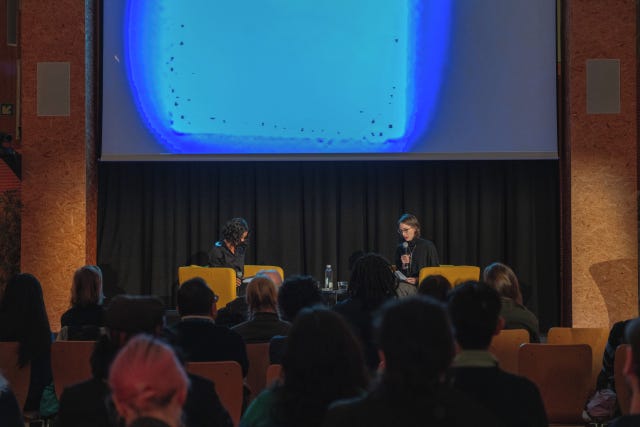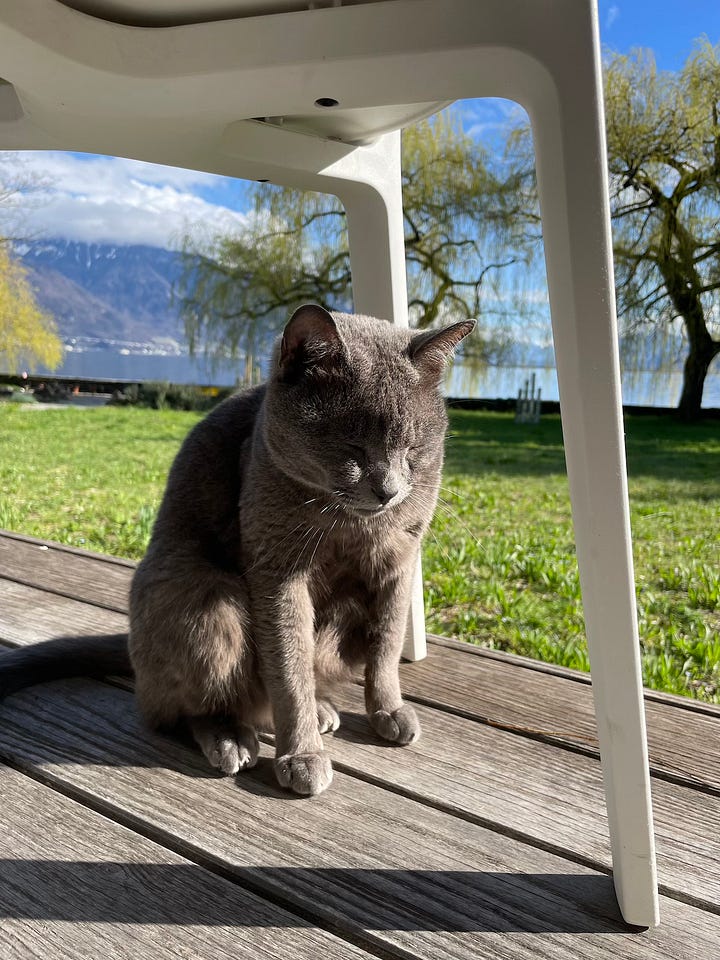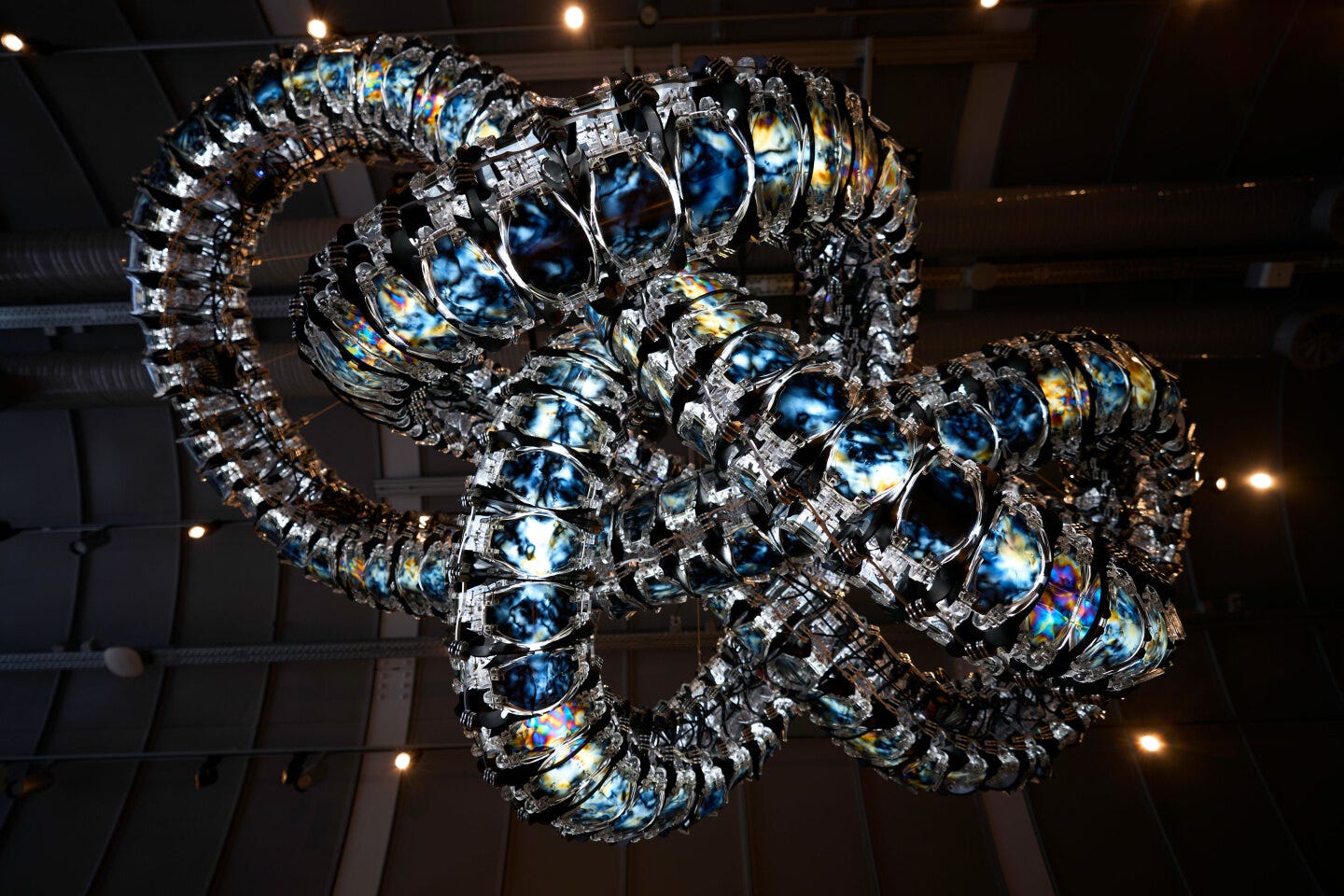Among the current generation of programs that put artists into sciencey places, I’ve always thought of Arts at CERN as a kind of mecca. That’s partly because CERN itself — the European Organization for Nuclear Research — is a science mecca. Under the ground of the Swiss particle physics research center is the LARGE HADRON COLLIDER, a 27-kilometer tube where physicists shoot beams at each other to smash particles together and, best case: discover the goo that came before the universe; worst case: create a black hole under the French-German border.1
CERN was founded in 1954; if you know about it, that might be because Tim Berners Lee was working there in 1989 when he invented the WorldWideWeb, HTTP, and URLs, or because of the time in 2012 that CERN researchers discovered the HIGGS BOSON PARTICLE, which I will let them explain. In 1972 James Lee Byars was the first curious artist to show up at CERN’s doorstep (which is more like a guarded gate) and ask to look around, talk to people, and make a project, followed by many other artists who invited themselves in. To CERN’s credit, they swung the gate open. A formal artist residency program was eventually launched in 2012. Since then over 200 artists have spent varying time in the labs; the center also supports newly commissioned art.
ARTISTS IN RESIDENCE PRIMER
A lot of my first novel riffed on what happens when you put artists in specifically corporate contexts — a 2010s trend that is definitely winding down now — which I viewed as the historical convergence of the made-up job of management consultant and the emerging role of the artist as “innovator” whose critique can be commodified for, best case: new products; worst case: art-washing crimes. My grand unified theory of corporatized artist residencies is here. The thesis is that art’s interests can’t (or at least should not) be made to align perfectly with other interests, whether that of science, profit, politicians, or the rich person funding the thing. When the Venn diagram between the art and the institution is forced/assumed to be a total crossover, the art tends to get sad/bad.
What can be exciting about programs that put artists in non-art contexts — whether companies, factories, government agencies, academia, or research centers — is precisely those spaces of misalignment. I think that productive misalignment is more likely to be possible in academia-adjacent places where profit is the not the point. (To some extent profit is the point everywhere, but sometimes the bottom line is fuzzier than others.) Enter science residencies.
Much is made of the fact that artists think like scientists (zany ideas! material experiments! accidental discoveries!), but, again, the differences are as important as the overlaps: the production of art is not the production of science. Art is an aesthetic pursuit, and it is circumscribed by the art world, which is its own kind of factory. (Also, since [insert year] artist have done a lot of work to critique their own factory.)
The art-collab progenitor programs I most often look to are Experiments in Art & Technology (E.A.T., est. 1967) and the Artist Placement Group (est. 1966). I’d place Arts at CERN in that lineage in the best possible sense.2 How to evaluate? I think it’s actually pretty straightforward: a successful crossover program is a place where the conversations are the point and the artists aren’t required to produce commodifiable work or prove their value. That means that of course the artists need enough $upport to buy them time and space, and the scientists also need enough time and space and curiosity to talk to them. In a lot of ways it’s a personal matchmaking project.
That all requires active curators and administrators who are doing the social-intellectual-emotional-reproductive labor of connecting people, which CERN has in Mónica Bello, the director since 2015. Residency curating is a specific and crucial type of work, because you have to communicate what you’re doing to a lot of different “stakeholders,” as in the public, the professionals, and the payers—who all speak different languages. That is one reason they have things like…
SUMMITS
In February Arts at CERN hosted a two-day summit themed UNCERTAINTY. I missed the first night of talks and performances because I was switching trains three times to get to Switzerland, but I was there for the second day: a series of presentations held inside a dome satisfyingly called the GLOBE OF SCIENCE AND INNOVATION by artists who’ve been residents at CERN and/or are interested in uncertain things. Then everyone got to go look at a particle collider.
I was THRILLED to find out that the first to present was my pal Elisa Storelli, a Swiss artist whose work you could call “clock-based” and who for a couple years has been working on a CERN project about how to measure time called Chronomorphology. (Once I wrote a sci-fi story about a time measurement system she invented.3) That day she was presenting a combo project called Rehearsing Duality with another artist, Rohini Devasher. Later in the day, I met a physicist who told me how excited her colleague was to show Elisa the facility’s new Cesium Atomic Clock (she also said that CERN just ordered the clock from Paris for $2 million and had to spend six months training one PhD student to use it; unverified). Atomic clock measurements are what all other clocks are based on. The atomic clock is why we have the unit called THE SECOND.


In their presentation, Elisa and Rohini said: “Machines create the effects they measure.” That means: clocks are not time. Clocks are an imperfect tool for trying to divide and get a handle on time. Another artist repeated this concept later: “We mistake the measurement for the thing itself.” People have been building clocks for thousands of years (sundial; cuckoo; Casio), but the minute you talk to a physicist they say things like, well, maybe it slides around forwards and backwards, maybe you invent it in your mind, maybe there’s actually no such thing as objective measurement, etc. For instance, clocks tick faster at higher altitudes, which is the sort of information that makes me very itchy.
Time measurement of the Western sort is also a tool of control: it created the working day through factory time; it was instrumental in colonial domination; it was fundamental for a globalized free market to synchronize itself. CERN artist Rasheedah Philips (while in the audience, I realized I was wearing a shirt designed by her collective Black Quantum Futurism) presented her new book: Dismantling the Master’s Clock, a “treatise on time, quantum physics, and racial justice,” which sounds like a research masterpiece about hegemonic time that might also describe (once and for all!) why sci-fi is not exactly causal but definitely intervenes in reality.
I loved listening to current artist-in-residence Robin Meier Wiratunga talked about his fascination with sand dunes, the shape of which is defined by their own ongoing disintegration, much like the entire universe, which is called metastable, aka it could fall apart at any moment but we sort of don’t think it will just yet. He said that in certain places, dunes make a weird drone music when the sand avalanches, so you can hear what entropy sounds like.
Robin was paired onstage with the 67-year-old Italian/Swiss artist Gianni Motti, the unexpected superstar of the day, who seems to have time-traveled perfectly intact from the Fluxus era with a sort of Dylan Moran French flair, and who in 2005 showed up and said he wanted to do a project. By way of explanation for his interest in CERN, he said: “When I was four years old someone told me the the Earth was a sphere and I cried for three days.” In keeping with this unpleasant revelation, in 1999 he launched Big Crunch Clock, “a digital clock that counts backwards the five billion years that we have left before the sun explodes.” At CERN, he ended up deciding to “be a proton” and ended up walking the the entire Hadron tunnel, which took six hours.
(Gianni went on to describe other projects of his that had nothing to do with Science, artworks that I am grateful to have learned about before we go extinct. Example 1: he sent an assistant on a six-month round-the-world trip wearing a T-shirt that said GIANNI MOTTI’S ASSISTANT. Upon return, he sent the assistant to the frontlines of an anti–Marine Le Pen protest; the following day the T-shirt and its wearer appeared on the front page of French newspapers. Example 2: For a piece called “The Feet of God,” he massaged Diego Maradona’s feet.)
While listening to artists (Gianni excepted) talk about the extent of scientific uncertainty about basic things like “wherefore is matter” and “is time in the room with us?” I was glancing at news headlines popping up on my phone such as “People Will Die”: The Trump Administration Said It Lifted Its Ban on Lifesaving Humanitarian Aid. That’s Not True,” and “DOGE Teen Owns ‘Tesla.Sexy LLC’ and Worked at Startup That Has Hired Convicted Hackers.” Everything was feeling uncertain in a very bad way. Will the remaining insects on Earth all die this year? Will the carbon sinks fail again? Will a teenager erase all CDC data so we don’t have a baseline to measure how many more people are going to die from polio? Science doesn’t occur in a vacuum (ha ha). One of the streets on the CERN campus is called Route Oppenheimer. That’s probably something an artist-in-residence would point out.
ANTIMATTER
My tour group was sent to see something called the Antiproton Decelerator instead of the Large Hadron Collider, a random choice that has possibly diverted the course of my life because now I am aware of antimatter. To be clear, I still do not understand what antimatter is, which makes my anxiety about its existence worse; the explanation they give you is that anti-particles are the exact opposite of normal particles, with positive/negative charge reversed. I gather that antimatter is something they discovered in the lab by smashing particles together, and now that they’ve discovered it exists, they have to figure out what it’s doing there.
The only way to study antimatter is to produce it by slamming matter, and due to the sheer energy usage of the rays and the cooling agents etcetera this makes antimatter the most expensive type of matter to produce in the world. I could not help but Google “practical applications of antimatter” and found answers from “crispier potato chips” to “interstellar travel,” so I guess it’s worth it.
Our tour guide was a scientist who I’d call the happiest person I’ve ever met. She described her job as “the best job in the world because I get to play all day and discover things no one has ever observed before.” For instance, she spent two years of her life underground in this fluorescent-lit lab in order to be one of the first people to discover how anti-hydrogen (a breed of antimatter) reacts to gravity. It falls, just like matter does.
The fact that antimatter falls normally in gravity was exciting but upsetting, because it did not solve what is called THE ASYMMETRY PROBLEM. The big upset caused by the discovery of antimatter is that there is much less antimatter than matter in the universe. The going explanation for the asymmetry of anti- and matter is that somehow antimatter behaves differently than matter, meaning that over millions of years, less of it has proliferated, leading to a huge imbalance between the two. But we don’t know the difference that accounts for that divergence. The tour guide told me that her life goal was to discover it. She did not seem pressed for time, maybe because time is a construct, but it needs to happen before someone puts tariffs on antimatter; on the other hand, what if Tesla gets dibs on antimatter first.
MESS
The best thing about watching science happen is that it looks like the drawer where I keep my mismatched USB cables. Much of the Antiproton Decelerator machine looks like it was patched together from leftover parts or soldered together from tinfoil and twine. It’s good to be reminded that knowledge is by-humans-for-humans and that science is a material craft as much as a theoretical project.



I WAS IN SWITZERLAND BECAUSE
I wanted to visit La Becque, another artist residency that dreams are made of (no science required), where I finished writing a book last spring. Besides being run by excellent people, friends are now in residence there, and I also needed to visit the only cat I’ve ever loved.
La Becque’s new open call starts in March. If you can brave the Asymmetry Problem, CERN has regular open calls.


I AM CURRENTLY
Re-reading Becoming Insomniac: How Sleeplessness Alarmed Modernity by Lee Scrivner. Inside this unassuming academic book you will find some of the most beautiful meditations and and historical explorations of sleep(lessness) available. I can’t tell you how many times I return to it. If either DOGE’s behavior or your new awareness of the heat death of the universe is keeping you up at night, try this.
Reading Hannah Proctor’s Burn Out: The Emotional Experience of Political Defeat, about a different kind of self-combustion, which is helping me not only in trying to parse my own flavors of disaffection or melancholy but in re-approaching my perennial question of how to write literature of hopelessness that is not just hopeless literature. “The sliver of difference between the empty heart and the broken one may seem negligible,” she writes, “but it is the difference between resignation and commitment or between left melancholy and mournful militancy.”
Watching Soundtrack to a Coup D’Etat by Johan Grimonprez, and still can’t figure out how someone told a story that way. Genius.
For a novel about what happens when your girlfriend accidentally produces a black hole in a physics lab, may I recommend Jonathan Lethem’s campus masterpiece.
Also doing great things: the Arts of Science Laboratory at Lausanne’s Technical University; MIT’s Center for Arts, Science, and Technology; and a new program I just learned about at the Niels Bohr Institute in Copenhagen.
From the end of the story: “The heat had finally caught up with them, like a combustion engine converting fuel into energy too fast, and now they had reached the threshold, a sonic inversion, a perfect curve, a benevolent wave bringing them back to the origin point where x meets why and all potentials, all possibilities converge on a single infinitesimally small intersection of lines. This sine wave would carry them back to the main event where they’d splintered off in the wrong direction.”









